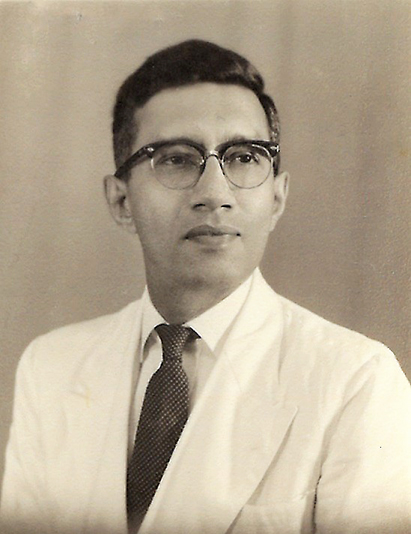Chandra Pal de Fonseka, (1919 – 2008)
MRCS and FRCS 1949, MB BS Ceylon 1944, MS 1956, LRCP 1949
Born 22nd December 1919, Panadura, Ceylon
 Chandra Pal de Fonseka was an accident and emergency surgeon in Bristol. He was born in Panadura, Ceylon, on 22 December 1919 into a family with many medical connections. His grandfather and two uncles were medical practitioners. His father, Hector Clarence de Fonseka, was a landowner who managed his own rubber and coconut estates. His mother was Inez Johanna née Gunewardene, whose three brothers studied medicine in London. Three of his cousins were also in medicine.
Chandra Pal de Fonseka was an accident and emergency surgeon in Bristol. He was born in Panadura, Ceylon, on 22 December 1919 into a family with many medical connections. His grandfather and two uncles were medical practitioners. His father, Hector Clarence de Fonseka, was a landowner who managed his own rubber and coconut estates. His mother was Inez Johanna née Gunewardene, whose three brothers studied medicine in London. Three of his cousins were also in medicine.
Chandra qualified in medicine from the University of Ceylon with the Sir Andrew Caldecott and Dadabhoy gold medals in his final examination. He then held house appointments in his own teaching hospital. At the end of the war it was difficult to get a passage to England, so he signed on as ship’s doctor to the Blue Funnel liner SS Demodocus, which was a naval auxiliary that had been held up in Colombo because her doctor had fallen ill and had been sent back to England. After a seven-month voyage, he arrived in Liverpool in November 1946. He attended the primary course at the Middlesex Hospital, passed the examination, and returned to Ceylon, where he underwent an arranged marriage to his first wife Rukmani Dias.
He returned to London to specialise in surgery, doing registrar jobs at Hammersmith, the North Middlesex and St Mark’s hospitals, enriching his experience by attending rounds and courses in a number of hospitals, among which he particularly valued his experience at St James’s, Balham. Having passed the FRCS in 1949, he became a resident surgical officer at St Bartholomew’s Hospital, Rochester, for two years and was then a registrar in Bath under Sholem Glaser who, with the other five general surgeons, gave him a glowing testimonial. There he met Peter London, then the senior registrar in orthopaedics.
From Bath he went to Bristol to widen his experience in cardiothoracic surgery under Ronald Belsey in the Frenchay Hospital thoracic unit for another two years. Belsey was unstinting in praising his clinical and operative skills. Whilst there he did his best to learn neurosurgery and plastic surgery, experience which he found particularly valuable on his return to Ceylon in 1956 as senior lecturer in the university department of surgery in Colombo.
Celyon had won its independence from Britain in 1948 without a drop of blood being shed. In 1958 communal riots broke out between the Tamil and Sinhalese populations. Chandra was in the theatre round the clock, dealing with gun-shot and knife wounds under the most difficult circumstances. His Tamil anaesthetist was beaten up by a Sinhalese mob. Buddhist priests complained to the administrator (a Tamil) that another doctor was treating Tamils rather than Sinhalese and the doctor was duly dismissed. The Prime Minister was assassinated in September. Laws were passed to outlaw the Tamil language and make Sinhalese the only official language.
Chandra was appointed professor of surgery in July 1960. The workload increased, especially in cancer. In 1962 his marriage was dissolved and he married his second wife, Maria Thérése Bertus in Colombo. In 1963 he was asked to set up a new department of surgery in Kandy. By now Chandra was one of the senior figures on the medical scene, having become president of the medical section of the Ceylon Association for the Advancement of Science. He had been granted a sabbatical year to study in the UK and had planned visits to the foremost centres in Britain and Germany, with introductions from Ronald Raven and Sir James Patterson Ross among others. But permission was repeatedly refused for his wife to accompany him until eventually she was allowed to go as a pilgrim to Rome with their new baby daughter.
They eventually made their way to the UK in 1964. There Chandra was appointed senior research fellow to set up the road accident research unit in Birmingham, the report of which was published in five volumes in 1969. During this period he was a clinical assistant to the accident department of Dudley Road Hospital. In 1969 the Medical Research Council invited him to set up a similar study into accidents in the home and he was appointed honorary lecturer in accident epidemiology in the department of public health in the University of Bristol. This project developed into the National Home Accident Monitoring Scheme of the Home Office. From then on he continued to work in the accident and emergency department until he retired in 1985.
He was a man of great integrity, charm and courtesy, who was widely admired for his qualities not only as a technical surgeon but as a teacher. He published extensively on road and domestic accidents, and was in demand as a lecturer in Europe and America.
His many outside interests included geology, cosmology and astronomy, and with Thérése he was a keen traveller and photographer. He was for many years treasurer of the Society of St Vincent de Paul, a charity for the disabled that was affiliated to the Catholic Church. He died on 5 April 2008, leaving his widow and the youngest of their two daughters.
John Blandy
Copyright (c) The Royal College of Surgeons of England
Image Copyright (c) Image provided for use with kind permission of the family
Publication Date: 17 October 2008 Royal College of Surgeons of England
https://livesonline.rcseng.ac.uk/client/en_GB/lives/search/detailnonmodal/ent:$002f$002fSD_ASSET$002f0$002fSD_ASSET:372748/one?qu=%22rcs%3A+E000565%22&rt=false%7C%7C%7CIDENTIFIER%7C%7C%7CResource+Identifier